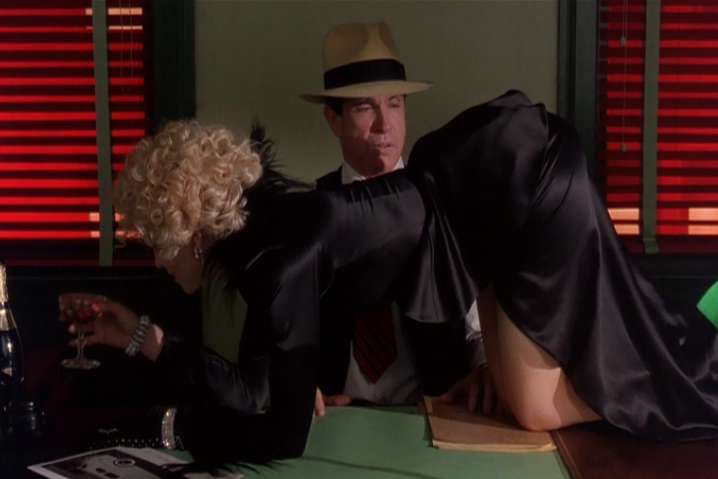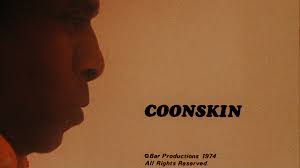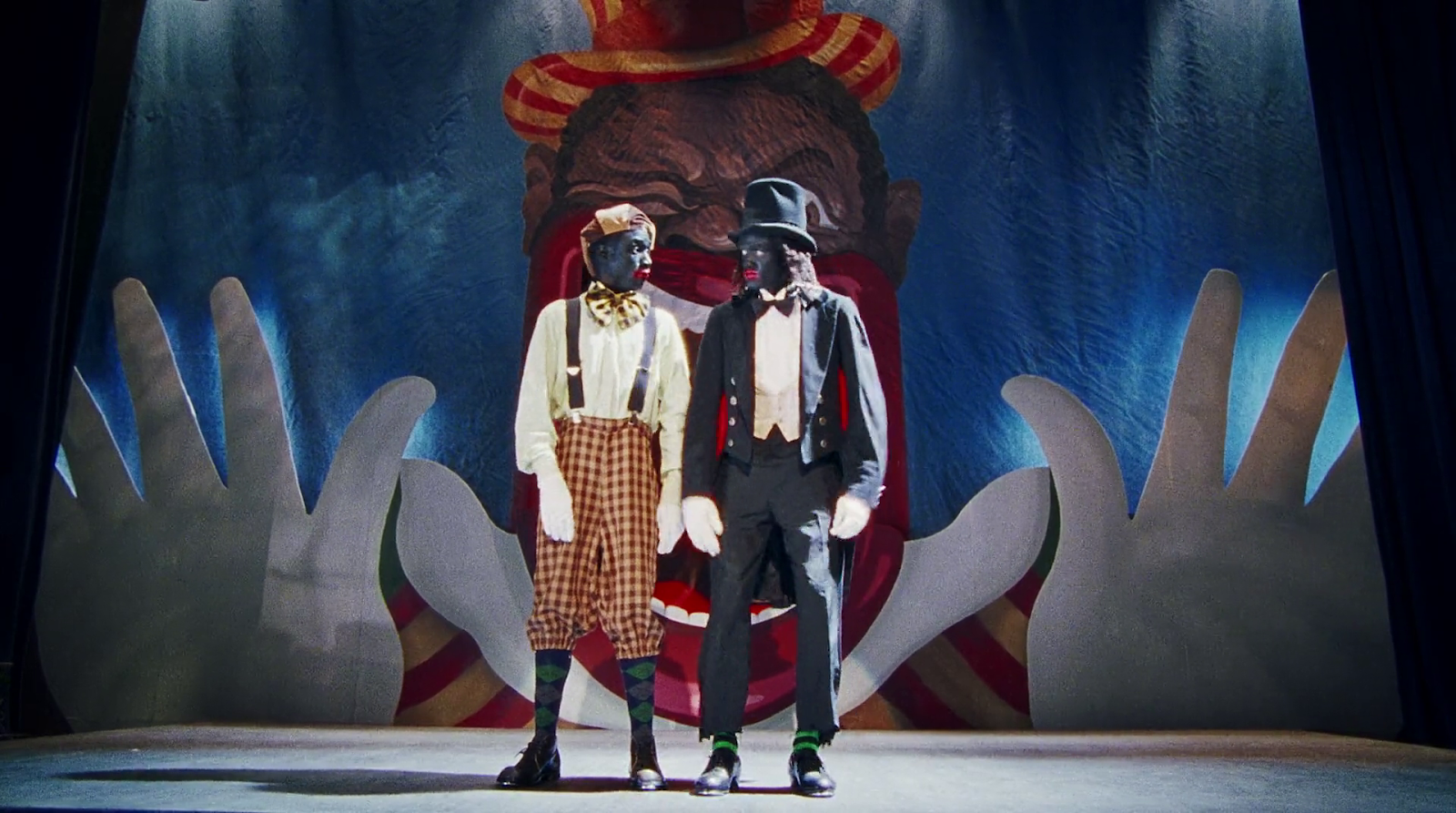When a person thinks of comic book movies, the typical image associated with the genre is that of superheroes fighting against supervillains in urban cities or other worlds either colorfully bright or intensely dark. While superheroes give comic book films their identity, some movies in the genre use styles and character archetypes that are remarkably reminiscent of classic film noirs. Some films are classic crime detective stories like Dick Tracy, while others involve anti-heroes and vigilantes taking the law into their own hands, like Batman. The type of noir found in these comic-book movies is Noir lite. James Naremore defines the style as "high production values, and straightforward comic-book heroic are mingled with over-the-top performances, double-entendre dialogue, dystopian satire, and a good deal of directorial self- consciousness." As over-the-top and otherworldly as these films appear, what sort of relations do they have with the noir style, and how does noir fit well within the comic book film genre?
Although there is no one answer to the question of how films qualify as noirs, there are distinct features in the category's aesthetics and mise en scène that are more heavily emphasized than usual. In multiple Batman films, Gotham City usually has heavy shadows and low-key lighting to create a city full of danger, corruption, and poverty, making it a character itself. Christopher Nolan's Dark Knight films give the city a realistic and modern approach as if it were an episode of Law & Order just with a superhero. In terms of live-action Batman films, the ones that come closer to the noir style are Tim Burton’s films, especially the first film Batman.
Gotham City feasts upon the noir style. In daylight, the city looks cold and gloomy from its faded colors, the shimmer of light, and streets covered in filth. At night, the city is practically consumed by darkness, smog, and shadows, where the light source comes from worn-out neon-lit signs, streetlights, car lights, and cryptically lit buildings lacking any color. The dark slum city makes for a perfect environment for Batman to blend into the shadows and for his rival, the Joker, to stand out among the crowd for his bright and festive appearance (sometimes aided by music sung by Prince). In the earlier scenes of the film, many criminals and corrupt officials wear trench coats and fedora hats when dealing in alleyways or fighting against the police in a smoke-polluted factory. What further gives Gotham City its unique noir flair is its German Expressionism influence. Some of the greatest film noirs were directed by German filmmakers, including Fritz Lang, who brought their expressionistic style to western audiences through crime films. Gotham has similar visual designs to the film Scarlett Street. However, it also has a futuristic gothic look like Metropolis (1927) with multiple factories and unusually designed buildings tightly close together with sharp edges. Tim Burton would play with the expressionist style for Gotham City more in Batman Returns (1992), only to have it look like a nightmare resembling The Cabinet of Dr. Caligari (1920) and Nosferatu (1922), rather than having the classic visual noir edge from the earlier film.
Despite the hero dressing up as a bat with gadgets, and the villain in clown makeup, most of the film’s environments are similar to the classic noir style. The plot and characters in Dick Tracy meet the standard noir tropes, but the overall look for the film is more unconventional than Burton's noir imagery in Batman. The film takes place in an urban city, has heavy shadows and creatively odd angles establishing an uncomforting environment, and most characters are dressed in classic tough-guy attire. Yet, as familiar as it all appears, the use of bright heavy comic book colors and designs strangely compliments the noir imagery. Sometimes the formation of light reflected within the city, or inside a building would cast shadows that looked like a painting in classic noirs. In Dick Tracy, there are literal distinguished matte paintings in plenty of scenes further highlighting the city as a weirdly unpredictable place of danger and dread. Film noirs notably had unconvincing rear projector effects (even for the time) for people driving in cars, while Dick Tracy goes "cheaper" by having a single-colored background with no sign of civilization. When buildings appear through a window, it would have the city painted in one color, looking like a painting on a wall or a cardboard cutout as opposed to appearing realistic.
The strangest part of the film's visual design is how the distinctly odd-looking characters phase no one. The gangsters Tracy fights all look like people from an old carnival freak show. Hardly any of them look like the common crooks that would appear in film noirs, for having a giant head with a tiny face, a flat-shaped head, a wrinkly old face resembling Freddy Kreuger's, huge lips and chins, and so on. What is even stranger about the characters’ appearance are the wardrobe colors. The gangsters wear clothing as big and bright as a suit the Joker would wear, while Dick Tracy wears a bright yellow coat and hat when he should be wearing darker clothing when sneaking around. No character acknowledges anyone's appearance unless they have no face, viewing it as the norm. As bizarre as Tracy's world appears and as unconvincing as the effects look, they contribute to a unique style unlike other comic book films and film noirs. Film noirs like Detour looked fake yet had an excessive style resembling a person's haunted memories with a grounded story. As many like to think back to classic black-and-white film noirs, there were a few exceptions shot in color, such as Leave Her to Heaven, for example. Dick Tracy is a combination of the styles for those films just made to look like a comic book with a conventional crime story in an exaggerated world that mostly plays itself as seriously as other film noirs.
The character of Dick Tracy is the typical detective who goes after the criminal underworld, with corrupted superiors holding him back. Tracy's personality is as hardboiled as that of a character like Sam Spade in The Maltese Falcon, who is rough and tough when facing criminals. But Tracy's actions are more in common with Leonard Diamond in The Big Combo. Both are protagonists with similar goals and a determination to place a powerful crime boss behind bars and each eventually finds interest in his rival's lover despite already having a girlfriend. In both films, each character has the criminals in his clutches a few times (before the climax), while at other times, he is at the mercy of his foe. Tracy, at one point, gets framed for murder by a mysterious antagonist leading to his arrest, like the victim and protagonist in the noir thriller Stranger on the Third Floor. Part of what makes Dick Tracy clever and yet unappreciated by audiences, is how the character and storyline are a homage to many noir tropes, just set within a comic book world capturing the film noir style. The movie is familiar in many ways, except hardly anything about it feels fresh and new outside of its visual appeal.
Tracy is a conventional by the number's noir protagonist, while Batman is subtler. It is not to say people were unaware of Batman's detective skills or that no dark comics starring the caped crusader came out before or during the release of Burton's Batman film. However, before the Burton film, Batman was portrayed as a campy superhero in film and television media. In the 89 movie, Batman looks as intimidating as a noir protagonist if they were to dress up like a Batman. Like Tracy and Diamond, Batman is obsessed with cracking down on the Joker's criminal organization, except Batman is portrayed as more than just a heroic protagonist who wants to clean the streets from crime.
Batman is the superhero equivalent of characters like Frank Bigelow in D.O.A. and Dave Bannion from The Big Heat, protagonists who are tormented or doomed souls fueled by revenge after losing something or someone important to them at the hands of criminals. Batman witnesses his parents murdered by a criminal as a small boy, traumatizing him to eventually become a vigilante, much as Sergeant Bannion goes rogue after a criminal kills his wife. Bigelow is a doomed protagonist who is slowly dying when seeking vengeance, whereas Batman mentally feels dead on the inside. Without the mask, Batman lives a public life as a wealthy millionaire, throwing parties and doing business with other Gotham officials. While active, he is quiet, hardly socializes, and usually keeps to himself in his giant dark mansion with his butler Alfred. His public figure Bruce Wayne is his mask, Batman is who he really is when no one else is around, or a costume in which to hide while intimidating other criminals. And unlike many versions of Batman that follow (unless it was a lazy loophole), this version of the character has the urge to kill, a ideology that is sacrilegious for die-hard fans, but in this version is not out of place due to how he isolates himself and dresses as a bat to take out his trauma by hurting and traumatizing other criminals. At the start of the film's third act, Batman's revenge is further provoked when he finds out the Joker is the person who killed his parents. And even after killing the Joker, Batman is unsatisfied. He keeps himself distant from social gatherings in Gotham and fights more criminals because his mental state and skills have led him to a position where he is the only one to bring justice to Gotham efficiently.
Catwoman is one of the few familiar noir elements in the sequel, making her the film's femme fatale. Elizabeth Cowie, in her article Film Noir and Women, believes "women may also fall victim to their involvement with the underworld, in an equivalent to the male criminal 'tough guy' thriller, using their beauty of course, but also and necessarily their intellectual talents for deceit." Before becoming Catwoman, Selina, like many femme fatales, including Susan from The Big Combo and Debbie in The Big Heat, was never directly involved in her boss' schemes. When stepping out of line, these characters would get either slapped in the face or brutally maimed by a hot pot of coffee. Unlike the others, Selina had no idea that her boss had a criminal plot, and after finding out, she gets pushed out the window, surviving the fall only to find herself psychologically damaged. Debby would seek revenge on her ex-boyfriend for the pain and scarring (physically and emotionally) he had brought to her. Catwoman would eventually do the same to her boss for similar reasons after constantly fighting against Batman, who gets in her way. Catwoman uses her beauty to let Batman's guard down before hitting or stabbing him with her claws. Catwoman would use sex appeal when encountering her boss under her Selina Kyle alter-ego, attracting him emotionally while using her wits to make up a story of having amnesia so that she can still walk around in public without the costume. Without using her attractive appearance, Catwoman convinces the Penguin that killing Batman will not be as efficient as framing him as a criminal, a popular noir trope, except it hardly goes anywhere after the police chase him shortly after he is framed.
A more traditional femme fatale, with some similarities to Catwoman, is the singer at the Club Ritz Breathless Mahoney in Dick Tracy. Breathless becomes a lover to the notorious Big Boy Caprice. Aware of Big Boy's criminal status and living off his benefits, at the cost of getting stripped as an individual now seen as an item he owns and will hit to put her in her place. Breathless finds attraction towards the only man who is openly willing to put Big Boy away, Dick Tracy, and seduces him every chance she gets for him to abandon the woman he dates. Tracy finds interest in Breathless but cannot leave the woman he loves. Sometimes her flirtation gets Tracy to kiss her, but when using her body does not work, she uses Tracy's obsession with catching Big Boy to lure him closer. Breathless achieves it by leading Tracy to an important meeting and refusing to testify against Big Boy unless Tracy commits to her instead of just protecting her.
In the end, Breathless is revealed to have an alter-ego as a gangster with no face credited as the Blank. Under her Blank disguise she goes after Big Boy Caprice, coming across as vengeful as Debby and Catwoman are against their abuser. But Breathless also plays an antagonistic role like Vera in Detour and Ellen in Leave Her to Heaven. In Detour, the doomed protagonist, Al, gets blackmailed by Vera over an accidental death he caused, while Tracy gets framed for murder at the hands of Breathless. Both women have different methods of turning against the main character; however, what makes them similar is that they are willing to turn them into the police if neither of them gets what they desire. Breathless is as hungry for Tracy's love, and affection as Ellen was for Richard, with the twisted mindset that if she cannot have him, nobody will, therefore taking great lengths to achieve it.
It is no surprise that a comic book film differs from the classic noir style, but as evidenced in Tim Burton's Batman films, and Dick Tracy, noir elements can still clash with the genre. Gotham City resembles noir visually, where Batman and The Joker are what give the film its comic book feel. The visuals in Dick Tracy look like an old-fashioned comic book, but it also has a story and characters that are purely forties and fifties noir, just with make-up and costumes as exaggerated as the backgrounds. The doomed vengeful noir protagonist is reflected through Batman, while Dick Tracy is a hardboiled authority figure achieving justice. And the female characters that attract the protagonists are seductive, cunning, and determined to get what they want, like many other great femme fatales. The difference is that one dresses up as a cat, and the other wears a faceless mask which is revealed to be the femme fatale in the twist, making everything come full circle to Breathless' character. Batman and Dick Tracy, while not the first, were the steppingstones for film noir in comic-book movies. Dick Tracy, while mostly forgotten, was praised by critics for having a unique visual style blending comic book and noir appearing fake yet beautifully stylized at the same time. Filmmaker Robert Rodriguez would adapt Sin City similarly to Dick Tracy by having a phony but visually appealing comic book environment in a crime-driven city. The notable differences are that Sin City is harsher in tone and only uses bright colors when needed in a mostly black-and-white film. The popularity and style of Burton's Batman not only revealed a darker film version of the character that intrigued audiences far more, but the nineties animated series, and Christopher Nolan's Dark Knight trilogy, would incorporate film noir elements as well. Even the recent Batman film pays tribute to the noir style, further proving that film noir is still relevant if not shown often in comic book cinema today.

























